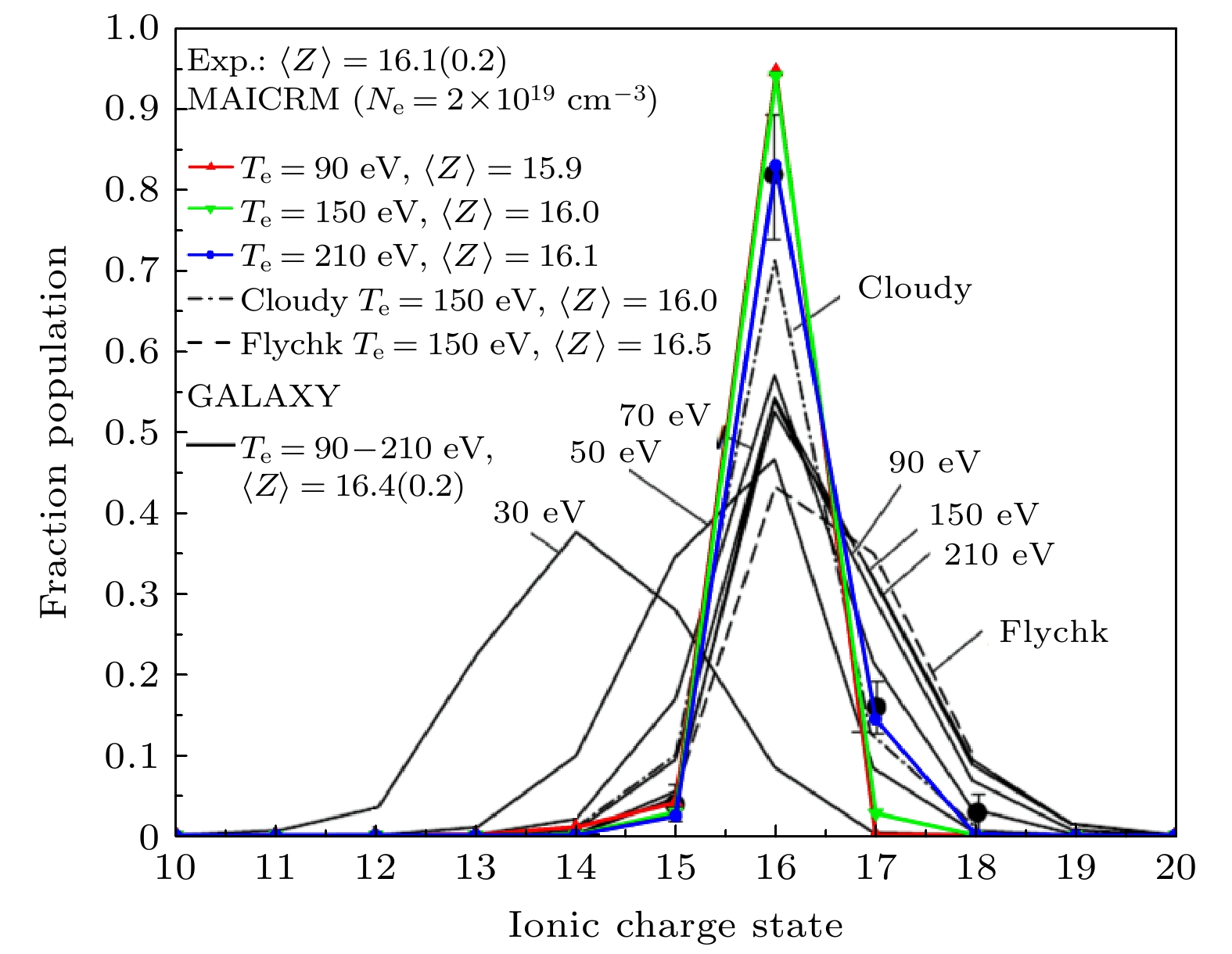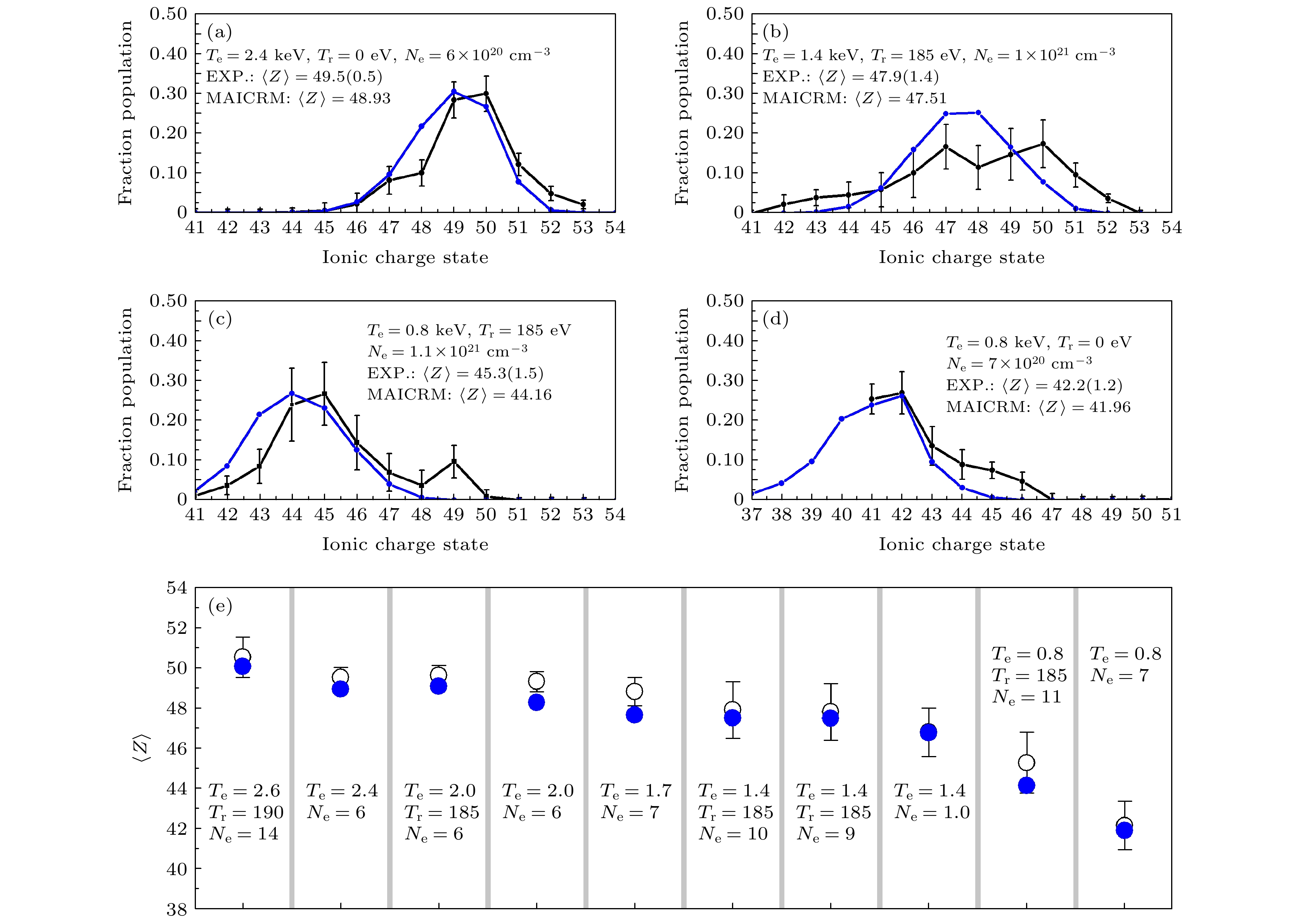-
在实验室和天体等离子体研究中, 原子/离子的激发、退激发以及电离、复合过程对等离子体的电离和能量平衡有着重要的影响. 在激光等离子体作用的辐射流体模拟中, 需要在线计算等离子体的平均离化度和吸收/发射系数. 在现有的计算能力下, 通常采用比较简单的平均原子(average atom, AA)模型进行在线计算. 随着实验技术和计算能力的发展, 急需发展能够在线计算的细致非平衡原子模型. 本文报道了最新发展的多离化度平均离子碰撞辐射模型(multi-average ion collisional-radiative model, MAICRM). 该模型用一个平均离子模拟等离子体中某一离化度所有离子的平均轨道占据数和布居, 即每个平均离子的轨道占据数为该离化度所有离子的轨道占据数的平均; 平均离子的布居等于该离化度离子的布居和. 平均离子的轨道占据数和布居通过迭代求解速率方法得到. 用该模型计算了Fe, Xe和Au非平衡等离子体的离化度分布, 计算结果与细致组态和超组态模型以及实验测量符合, 而计算量相对于细致组态/超组态大大降低. 预期该方法能与辐射流体程序耦合, 实现细致非平衡原子模型的在线计算.Aiming at the requirement of the on-line detailed atomic model in radiation hydrodynamic simulations, we propose a general model, multi-average ion collisional-radiative model (MAICRM), to rapidly simulate the ionization and charge state distribution of hot dense plasma under non-local thermal equilibrium (NLTE) conditions. In this model, an average ion is used to characterize the features of all the atomic states at one single charge state, including the average orbital occupation and the total population of the atomic states. The rate equations for the orbital occupations and the population are derived from the rate equations of the detailed configurations and separated into two sets under the two assumptions: one is the single orbital rate coefficients (including no occupation nor hole number of the relative orbital) that are only dependent on the charge state, and the other is the coupling of the excitation/de-excitation process and ionization/recombination process, which are weak. Namely, the orbital occupation of an average ion is mainly determined by the excitation/de-excitation process under a certain density and temperature; the population of the average ions is determined by the ionization/recombination process with the fixed orbital occupation. The two sets of rate equations are solved sequentially and iteratively until a set of converged orbital occupation and population values is obtained. The interplay between the occupation and the population is implicit in the excitation/de-excitation rate coefficient and ionization/recombination rate coefficient, each of which is a function of electron density and temperature as well as occupation. In this work, using the newly developed method and codes, the mean ionizations and charge state distributions of Fe, Xe and Au plasmas under different plasma conditions are calculated and in good agreement with the experimental results and DCA/SCA calculations. Meanwhile, compared with the DCA/SCA calculations, in which hundreds or thousands of detailed atomic states at each charge state are considered to obtain a converged ionization balance, MAICRM only considers one kind of ion at one single charge state, thus the computational cost of MAICRM is much reduced and lower than that of DCA/SCA. Due to its good degree of accuracy for ionization balance and its low computational cost, MAICRM is expected to be incorporated into the radiation hydrodynamic program to realize the online calculation of detailed nonequilibrium atomic models in the future.
-
Keywords:
- non-local thermal equilibrium plasma /
- average-ion /
- rate equation /
- radiation hydrodynamic
[1] Lindl J D 1995 Phys. Plasmas 2 3933
 Google Scholar
Google Scholar
[2] Whitney K G, Pulsifer P E, Apruzese J P, et al. 2001 Phys. Plasmas 8 3708
 Google Scholar
Google Scholar
[3] Faussurier G, Blancard C, Decoster B A 1997 Phys. Rev. E 56 3474
 Google Scholar
Google Scholar
[4] Bauche-Arnoult C, Bauche J, Klapisch M 1988 Adv. At. Mol. Phys. 23 131
[5] Bar-Shalom A, Oreg J, Goldstein W H, Shvarts D, Zigler A 1989 Phys. Rev. A. 40 3183
 Google Scholar
Google Scholar
[6] Ralchenko Y 2001 J. Quant. Spectrosc. Radiat. Transf. 71 609
 Google Scholar
Google Scholar
[7] Huo W Y, Lan K, Li Y S, et al. 2012 Phys. Rev. Lett. 109 145004
 Google Scholar
Google Scholar
[8] Huo W Y, Li Z C, Chen Y H, et al. 2016 Phys. Rev. Lett. 117 125002
 Google Scholar
Google Scholar
[9] Rosen M D, Scott H A, Hinkel D E, et al. 2011 High Energy Density Phys. 7 180
 Google Scholar
Google Scholar
[10] Jones O S, Suter L J, Scott H A, et al. 2017 Phys. Plasmas 24 056312
 Google Scholar
Google Scholar
[11] Stewart J C, Pyatt K D 1966 Astrophys. J. 144 1203
 Google Scholar
Google Scholar
[12] Foord M E, Heeter R F, van Hoof P A M, et al. 2004 Phys. Rev. Lett. 93 055002
 Google Scholar
Google Scholar
[13] Klapisch M, Schwob J L, Fraenkel B S, Oreg J 1977 J. Opt. Soc. Am. 67 148
 Google Scholar
Google Scholar
[14] Kelly R L 1987 J. Phys. Chem. Ref. Data 16 860
[15] Ferland G J, Korista K T, Verner D A, et al. 1998 Publ. Astron. Soc. Pac. 110 761
[16] Rose S J 1998 J. Phys. B 31 2129
 Google Scholar
Google Scholar
[17] Chung H K, Morgan W L, Lee R W, et al. 2003 J. Quant. Spectrosc. Radiat. Transf. 99 102
[18] Chenais-Popovics C, Malka V, Gauthier J C, et al. 2002 Phys. Rev. E. 65 046418
 Google Scholar
Google Scholar
[19] Peyrusse O 2000 J. Phys. B. 33 4303
 Google Scholar
Google Scholar
[20] Bauche J, Bauche-Arnoult C, Klapisch M 1991 J. Phys. B. 24 1
 Google Scholar
Google Scholar
[21] Heeter R F, Hansen S B, Fournier K B, et al. 2007 Phys. Rev. Lett. 99 195001
 Google Scholar
Google Scholar
[22] van Regemorter H 1962 Astrophys. J. 136 906
 Google Scholar
Google Scholar
[23] Mewe R 1972 Astron. Astrophys. 20 215
[24] Kramers H A 1923 Philos. Mag. 46 836
 Google Scholar
Google Scholar
[25] Lotz W 1967 Z. Phys. 206 205
 Google Scholar
Google Scholar
-
图 2 Xe等离子体在
${T_{\rm{e}}} \!=\! 415\;{\rm{ eV}}$ ,${N_i} \!=\! 4.75 \!\times \! {\rm{1}}{{\rm{0}}^{18}}\;{\rm{ c}}{{\rm{m}}^{{{ - 3}}}}$ 时的离化度分布. 括号里的数是实验的误差范围Fig. 2. The comparison of the mean ionization and CSD of Xe plasma at
${T_{\rm{e}}} = 415\;{\rm{eV}}$ ,${N_i} = 4.75\times 10^{18}\;{\rm{c}}{{\rm{m}}^{{{ - 3}}}}$ . The data in parenthesis is the experimental uncertainties.图 3 MAICRM计算的不同状态下Au等离子体的
$\langle Z \rangle$ 和离化度分布与实验测量[21]的比较. (a), (b), (c)和(d)中括号里的数是实验误差, (e)中电子温度Te, 辐射场温度Tr和电子密度Ne的单位分别是keV, eV和1020 cm–3Fig. 3. The comparisons of the mean ionization
$\langle Z \rangle$ and CSD of Au plasma between MAICRM and the experimental results[21]. In panels (a), (b), (c) and (d) the data in parenthesis are the experimental uncertainties. In panel (e) the units of electron temperature Te, radiation temperature Tr and electron density Ne are keV, eV and 1020 cm–3 respectively. -
[1] Lindl J D 1995 Phys. Plasmas 2 3933
 Google Scholar
Google Scholar
[2] Whitney K G, Pulsifer P E, Apruzese J P, et al. 2001 Phys. Plasmas 8 3708
 Google Scholar
Google Scholar
[3] Faussurier G, Blancard C, Decoster B A 1997 Phys. Rev. E 56 3474
 Google Scholar
Google Scholar
[4] Bauche-Arnoult C, Bauche J, Klapisch M 1988 Adv. At. Mol. Phys. 23 131
[5] Bar-Shalom A, Oreg J, Goldstein W H, Shvarts D, Zigler A 1989 Phys. Rev. A. 40 3183
 Google Scholar
Google Scholar
[6] Ralchenko Y 2001 J. Quant. Spectrosc. Radiat. Transf. 71 609
 Google Scholar
Google Scholar
[7] Huo W Y, Lan K, Li Y S, et al. 2012 Phys. Rev. Lett. 109 145004
 Google Scholar
Google Scholar
[8] Huo W Y, Li Z C, Chen Y H, et al. 2016 Phys. Rev. Lett. 117 125002
 Google Scholar
Google Scholar
[9] Rosen M D, Scott H A, Hinkel D E, et al. 2011 High Energy Density Phys. 7 180
 Google Scholar
Google Scholar
[10] Jones O S, Suter L J, Scott H A, et al. 2017 Phys. Plasmas 24 056312
 Google Scholar
Google Scholar
[11] Stewart J C, Pyatt K D 1966 Astrophys. J. 144 1203
 Google Scholar
Google Scholar
[12] Foord M E, Heeter R F, van Hoof P A M, et al. 2004 Phys. Rev. Lett. 93 055002
 Google Scholar
Google Scholar
[13] Klapisch M, Schwob J L, Fraenkel B S, Oreg J 1977 J. Opt. Soc. Am. 67 148
 Google Scholar
Google Scholar
[14] Kelly R L 1987 J. Phys. Chem. Ref. Data 16 860
[15] Ferland G J, Korista K T, Verner D A, et al. 1998 Publ. Astron. Soc. Pac. 110 761
[16] Rose S J 1998 J. Phys. B 31 2129
 Google Scholar
Google Scholar
[17] Chung H K, Morgan W L, Lee R W, et al. 2003 J. Quant. Spectrosc. Radiat. Transf. 99 102
[18] Chenais-Popovics C, Malka V, Gauthier J C, et al. 2002 Phys. Rev. E. 65 046418
 Google Scholar
Google Scholar
[19] Peyrusse O 2000 J. Phys. B. 33 4303
 Google Scholar
Google Scholar
[20] Bauche J, Bauche-Arnoult C, Klapisch M 1991 J. Phys. B. 24 1
 Google Scholar
Google Scholar
[21] Heeter R F, Hansen S B, Fournier K B, et al. 2007 Phys. Rev. Lett. 99 195001
 Google Scholar
Google Scholar
[22] van Regemorter H 1962 Astrophys. J. 136 906
 Google Scholar
Google Scholar
[23] Mewe R 1972 Astron. Astrophys. 20 215
[24] Kramers H A 1923 Philos. Mag. 46 836
 Google Scholar
Google Scholar
[25] Lotz W 1967 Z. Phys. 206 205
 Google Scholar
Google Scholar
计量
- 文章访问数: 7980
- PDF下载量: 158
- 被引次数: 0














 下载:
下载:








